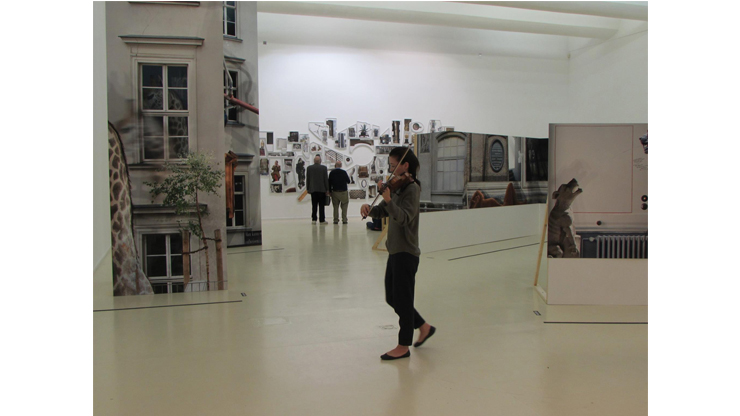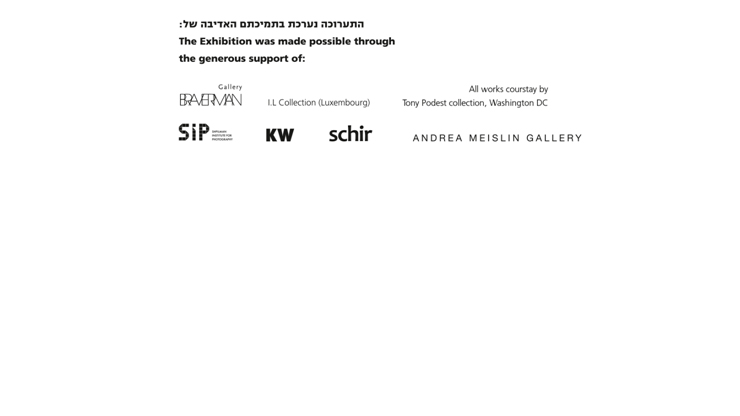
The presentation of the panoramic photographs on wooden side scenes functions as a threedimensional installation, which recalibrates our sense of the architectural space and its relation to our human scale. We thus find ourselves wandering across each photograph as if wandering through the actual KW Institute building, raising our head to the top of the building as if participating in a parable for the relations between illusion and reality, which are heightened by the camera’s deceptive realism. Over time, Azoulay has come to be increasingly interested in casting a reflexive gaze at the act of artistic creation itself, its components and history. In the current exhibition, the internal and external spaces of the KW Institute in Berlin are documented,
and actually function as kaleidoscopic analogies for the creator and her creation. The KW Institute for Contemporary Art in Berlin is located in a historical building slated for preservation. Following her arrival there, Azoulay was drawn to a large crack running across the building’s façade, due to a controversial construction project recently undertaken in an adjacent building. Azoulay arrived at KW at a time of far-reaching changes at the institute following the appointment of a new chief curator, Ellen Blumenstein. Blumenstein was interested in exposing the original structure of the exhibition spaces and revealing the later additions to them. She collaborated with the artist Nedko Solakov on the Markierung (2013) project, in the course of which they wandered through the KW building while Solakov wrote Blumenstein’s comments on the walls and used a black marker to add drawings, like graffiti inscriptions expressing a kind of juvenile rebellion against the concealment and effacement of the past. These inscriptions are included in Azoulay’s images, and contribute to presenting the museum as a distilled reflection of the economic and social processes of change taking place in the city. The art institute and its internal and external spaces are thus transformed, in Azoulay’s work, into a complex symbolic sphere that reflects the urban dynamics of Berlin as a city in the process of renewal, while simultaneously articulating the struggle taking place within it between the forces of the past, present and future. The rear wall of the exhibition space at the Herzliya Museum features a sort of index map titled Shifting Degrees of Certainty. This map includes 85 framed photographs that capture various objects and architectural elements – including an effaced inscription on a marble plaque, a music stand, a stuffed giraffe head, an electric switch, a marble sculpture, a skull, a window, a glass flask, and more. Further observation reveals the mysterious figures of a flutist and a female violinist engrossed in the act of making music, who appear alongside the objects in the large panoramic photographs, assembled in what appears to be an ongoing process of montage.
Azoulay photographed these objects with a sophisticated macro lens, on a 1:1 scale, and the impact of her photographs owes to her insistence on capturing the objects’ plastic qualities – such as the large crack in the KW façade, which was photographed from a crane especially commissioned for that purpose. Consequently, some of the objects in the final images seem to have been photographed, directly, while others appear as an amalgam of numerous photographs. The objects captured by Azoulay with her digital camera come together to create a kind of imagined collection, underscoring the gap between the actual object and its representation – perhaps as an analogy to the object as a form of testimony. At the same time, Azoulay is not concerned with the object itself, but rather with its documentation, which articulates her indirect contact with the past, as well as the indirect means by which it is transmitted in the present. In the current project, Azoulay made use of new expressive means – text and sound. She ventured out on a partly real, partly fictitious investigative journey to study a range of objects and architectural elements. With the help of a research assistant, she analyzed her findings based on the information provided by conversations with experts, archival research, appeals to institutions and municipal authorities, interviews with people who lived near these objects, and data collected in libraries. In most cases, she was able to uncover the history and origin of the photographed objects and elements. In a factual tone of the kind associated with reportage, Azoulay presents her findings in writing. Yet despite her general adherence to the facts, every so often her texts are infused with a personal, or even fictional, tone or turn. In some cases, she even expresses regret for actions taken. In other instances, she recounts in detail a completely fabricated story. The texts were recorded by Azoulay in three languages (Hebrew, English, and German), and can be listened to on the audio guide available to exhibition visitors. This artistic strategy largely undermines the certainty of historical research and the objectivity of the archive. It reflects the difficulty inherent to accessing information while exposing the mechanisms underlying German bureaucracy, characterized as it is by rigidity, formality, and distance. Azoulay thus becomes acquainted with the past by studying the mechanisms that guide it. Her current exhibition bespeaks the assimilation of increasingly sophisticated conceptual and formal strategies, which have already been present in various ways in her earlier photographs. Azoulay’s oeuvre presents complex, in-depth theoretical, emotional, visual, and historical layers, turning back to the past in order to sketch it as she contemplates the picture of the present.
This collaboration included a visit to Israel by Gabriele Horn, Director of KW, and Friedrike Schir, Director of Schir Foundation. As Chief Curator of the Shpilman Institute at the time, I organized (together with SIP’s former Associate Curator Orit Bulgaru) a series visits to the studios of Israeli artists working in the medium of photography. At the end of this process, the KW curators chose to award the residency in Berlin to Ilit Azoulay.

Less Reading...

